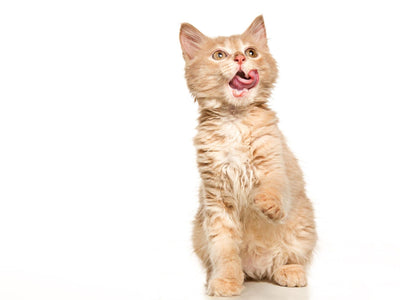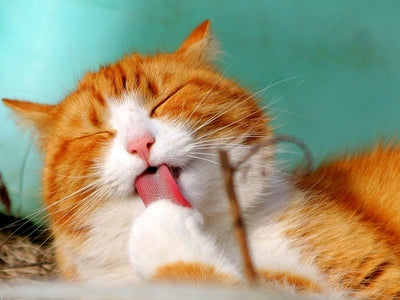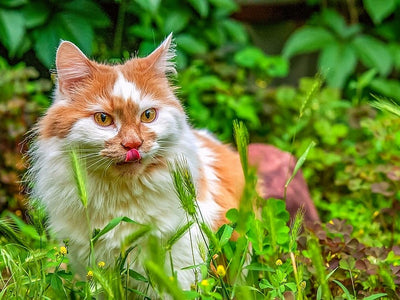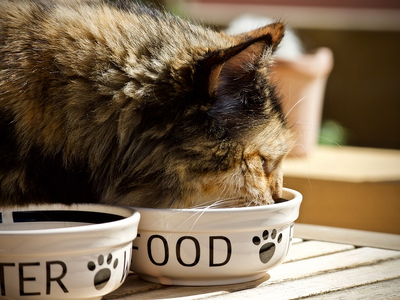19.09.2022
Cautiously embracing freedom—when can a kitten go outside?
It’s common to be conflicted about when to introduce your new kitten to the great outdoors. While there are several safety concerns involved, many people worry they’re being cruel to their kitty by keeping them indoors all the time.
So, when can a kitten go outside? You must factor in your kitten’s development status, emotional state, lifestyle preferences, and their environment. This guide will carefully examine:
- When to let a kitten outside
- How to ensure a kitten stays safe
- How long they can be away from home
- What dietary changes to make if they tend to escape and roam around
At what age can a kitten go outside?
Until a few decades ago, almost all domesticated cats were cared for as outdoor pets. They would roam about farms and barns, hunting mice, insects, and other crawly vermin, only to check back in with their humans during meal times.
Outdoor setups have changed significantly, making it unsafe for cats to stay out all the time, especially in an urban environment. As far as kittens are concerned, vets don’t recommend letting them out till they have completed their growth and are near their adult weight.
Once they’re over 15 weeks old, you can take them out for supervised playtime, provided:
- Their health and general conduct are suitable
- They are not recently adopted

All these new smells, colours, and feelings—my heart might explode from happiness, hooman!
Source: Javiermirapeidro
Letting your kitten outside—health and behaviour prerequisites
Most kittens can enjoy outdoor playtime once they are four to five months old as long as they are:
- Fully vaccinated—The grand outdoors is a major threat for unvaccinated kittens because their immune system is still developing. Exposure to pathogens in the atmosphere often triggers diarrhoea, vomiting, and fever, which can be life-threatening. The vaccination is over by 16 weeks, but you should wait for another two weeks to ensure your kitty has their antibodies developed
- Neutered or spayed—Kittens hit adolescence by the time their vaccine schedule is over, which means they can procreate. You should have your kitten fixed before they go outside to prevent unwanted pregnancies or hormonal behaviour, such as:
- Picking up fights with other cats or dogs
- Acting aggressively when you try to contain them
- Escaping your supervision to explore the neighbourhood
- Well-trained—Kittens can be easily overwhelmed by the sensory overload outdoors, so you should be able to calm them down if the need arises. Ensure your kitten is adequately trained to basic commands like Sit, Stop, and Wait, which will help you manage their actions in an unpredictable environment. You should also teach them not to eat anything they fancy, which includes toxic plants and grass, decomposing raw meat, and litter—that may cause food poisoning
How long before a newly adopted kitten can go outside?
If you’ve recently adopted an adolescent kitten, you should wait for at least a month before taking them outside. Kittens freshly separated from their mother have to adjust to their adoptive homes, like sleeping in a new bed or using the litter tray. An outdoor trip could be too stressful at this time. Focus on making your kitten feel emotionally secure during their first few weeks with you before taking them on a field trip.
Introducing a kitten to the outdoors—risk factors and safety precautions
Check out the top risk factors related to letting kittens outdoors in the following table:
|
Hazards |
Safety measures |
|
Traffic accidents |
|
|
Run-ins with hostile animals |
|
|
Flea and tick infestations |
|
|
Theft or escape |
|

I’m starting to think I’m lost. I’m famished, and I cannot smell my mummy anymore—can you help me find my way back home, hooman?
Source: Ramazan Erdem
How long should a kitten be outside, and is it necessary?
Families in peaceful rural environments have cats who roam unsupervised 24/7, but it’s far too big of a risk to take if you’re living in a busy area. Many people also build outdoor houses where their cats have constant access to food, water, and bedding. Still, experts don’t recommend keeping cats as outdoor pets as it turns them into predatory hunters, which spells trouble for harmless birds, squirrels, and frogs.
Outdoor cats typically have a shorter lifespan because of their risky lifestyle. The best strategy is to keep your kitten mostly indoors and provide adequate stimulation with toys and games that facilitate athletic movements (cat trees, catnip mice, etc.) and pose a mental challenge (puzzle feeders, cat maze, and similar).
Your kitten’s breed and genetics also dictate their desire to go outside. Check out some of the popular indoor- and outdoor-loving cats:
|
Cats who prefer being indoors |
Cats who need occasional outdoor time |
|
While keeping a kitten safe indoors is not cruel, you can build them an enclosed catio (a cat-patio) if you want them to enjoy outdoor playtime safely.

I brought you a special present because I love you so much, hooman. Why are you cross?
Source: Dorothea OLDANI
Are the dietary requirements of indoor and outdoor kittens different?
Both indoor and outdoor cats need a high-protein diet to stay fit and active. The optimal nutrient ratios should be:
- Animal protein—more than 50% (the protein should ideally be from whole meat and not meat derivatives)
- Animal fat—about 20%
Felines are hardcore carnivores, so they don’t need carbs in their diet. They should get all their daily calories from animal proteins and fats.
Outdoor cats need a high-calorie diet as they spend more energy than indoor cats. If your kitten plays outdoors often, give them meals in larger portions. On average, kittens growing indoors need about 50–60 calories per kilo of their body weight daily, but those venturing out frequently may require up to 80 calories. Keep in mind that once your kitten becomes an adult cat, they should eat only 40–45 calories per kilo of their body weight every day to stay healthy (on a moderately active lifestyle).
A regular wet-food diet works best for all kittens, irrespective of lifestyle preferences, as it’s hydrating and packed with yummy meat. Wet food is more bioavailable than dry food, which means the feline digestive system can absorb nutrients better from wet food. The artificial texture of kibble can also be dissatisfying to felines, making them go on hunting sprees more often to fulfil their urges to consume real meat. Dry food also has a lot of carbs, which can cause obesity, diabetes, constipation, and IBS in the long run.

Indoor fests or outdoor quests—kitties are at their sharpest best with Untamed!
Image (c) Untamed
Adventurers or homebodies—Untamed keeps all kitties fit!
Finding the right kitten food can be overwhelming because there are hundreds of products to choose from. Go for wet food from Untamed to improve your kitten’s overall well-being and prevent common nutrition-related diseases because:
- We use human-grade whole meat for our gravy and jelly dishes, which is far more nutritious than chemically treated pet-grade ingredients like bone or organ digests
- Our food has more than 60% animal protein, suitable for:
- Helping kittens achieve their target weight and muscle tone
- Boosting immune function
- Promoting timely teething and boosting dental health
- Maintaining balanced energy levels and sleep schedule
- We prepare allergen-free meals, avoiding stuff that can destabilise your kitten’s gastrointestinal health, including:
- Vegan proteins
- Dairy
- Corn, rice, and other grains
- Sugar
- Beef (a common food allergen for felines)
- Harmful preservatives
- Chemical taste enhancers
- Our formulas are developed by vets to provide amino acids (like arginine and taurine), vitamins, minerals, and healthy fats in suitable proportions

Cat food shouldn’t be a colourful concoction of fillers, chemicals, and undefined meat—at Untamed, we value transparency.
Image (c) Untamed
Which Untamed product is perfect for your kitten?
Untamed products work for cats at every life stage, but if you have a freshly weaned-off kitten, give them our single-protein-source meals—Chocka Chicken in Jelly and Tuck-in Tuna in Jelly. These products are ideal for kittens with a high risk of developing an upset tummy due to food sensitivities. Once they’re older, introduce them to our other delicacies:
We have tested our products on fussy felines, so you don’t have to worry about rejections. Untamed meals are always licked clean because we use gentle steaming to bring out the tempting natural flavour, aroma, and texture of meat!
Take our TRY NOW quiz to see which Untamed products your kitty would adore. You can order our tailor-made taster pack at the best price!
What cat parents say about Untamed
Untamed is one of the best-reviewed cat food brands in the UK. Our clients have reported the following improvements after their kitties switched to Untamed:
|
Period on Untamed |
Benefits |
|
A week |
|
|
Three months |
|
|
Four months and beyond |
|
Your kitten can stay healthy on Untamed throughout their adult and senior years as long as you adjust their portions to their lifestyle preferences and activity levels. Regular intake of our grain-free meals prevents common feline diseases like diabetes, UTIs, bladder stones, and arthritis.

Hunting is so last-century. New-age kitties enjoy the tastiest meals delivered by well-trained and well-intentioned hoomans.
Image (c) Untamed
Order our taster pack!
Order the Untamed taster pack online in a few easy steps:
- Take our TRY NOW quiz
- Select the desired products
- Place the order
You’ll get your taster pack the next day, and the set will last about a week. Once your furry friend chooses their favourites, go for our cat food delivery service. You can expect customised meal boxes on the same date every month. All our clients enjoy:
- Free shipping
- Straightforward modification of orders
Untamed conducts ethical and carbon-footprint neutral operations. We use:
- 100% recyclable packaging
- Meat from cruelty-free farms
- Fish sourced from dolphin-safe suppliers


![Associated image for Best food for Ragdoll cats in the UK [Broken Down]](http://untamed.com/cdn/shop/articles/featured_best_food_for_ragdoll_cats_uk_400x300_crop_center.jpg?v=1646818249)







![Associated image for What human food can Sphynx cats eat? [Comprehensive list]](http://untamed.com/cdn/shop/articles/what_human_food_can_sphynx_cats_eat_Featured_400x300_crop_center.jpg?v=1648705074)

